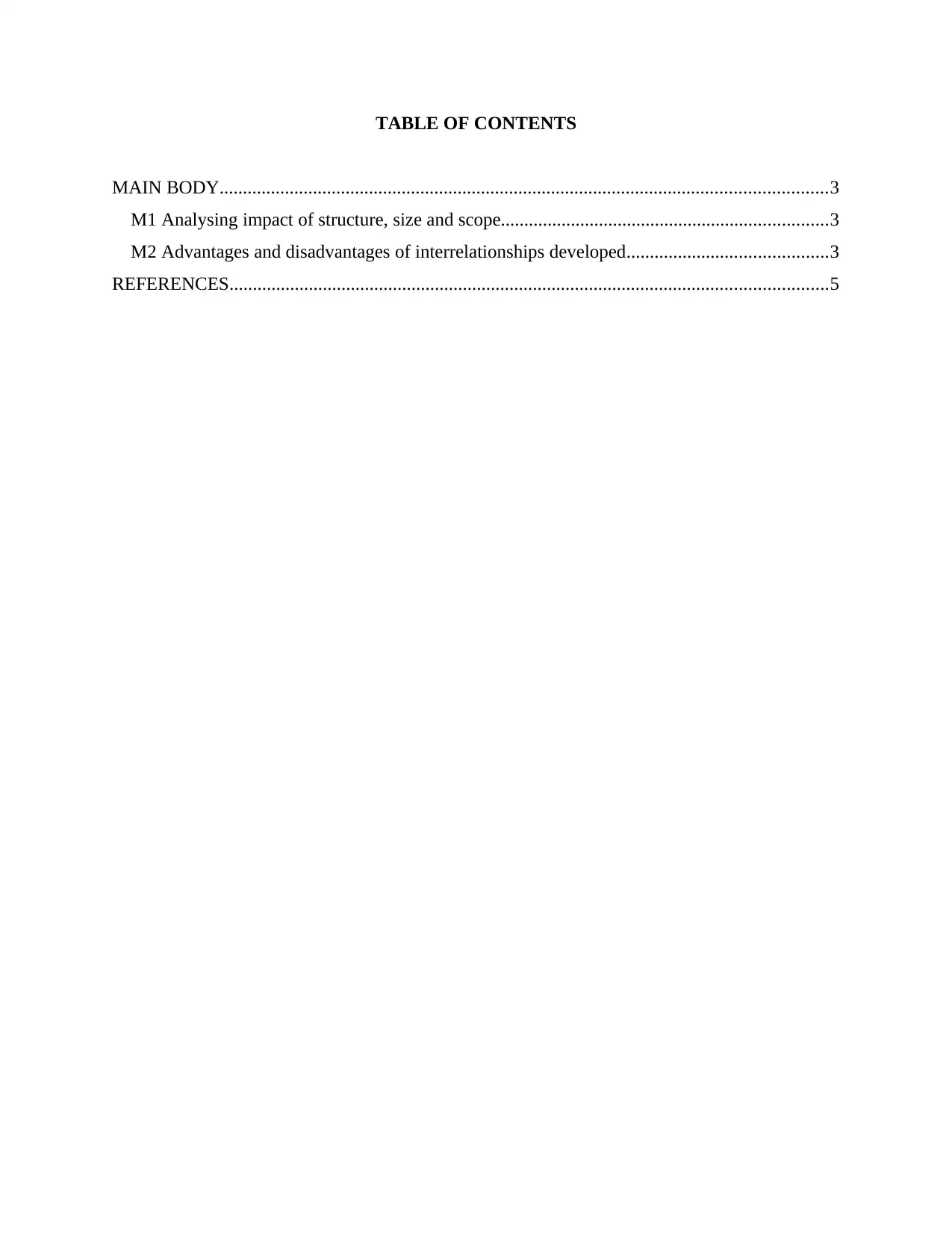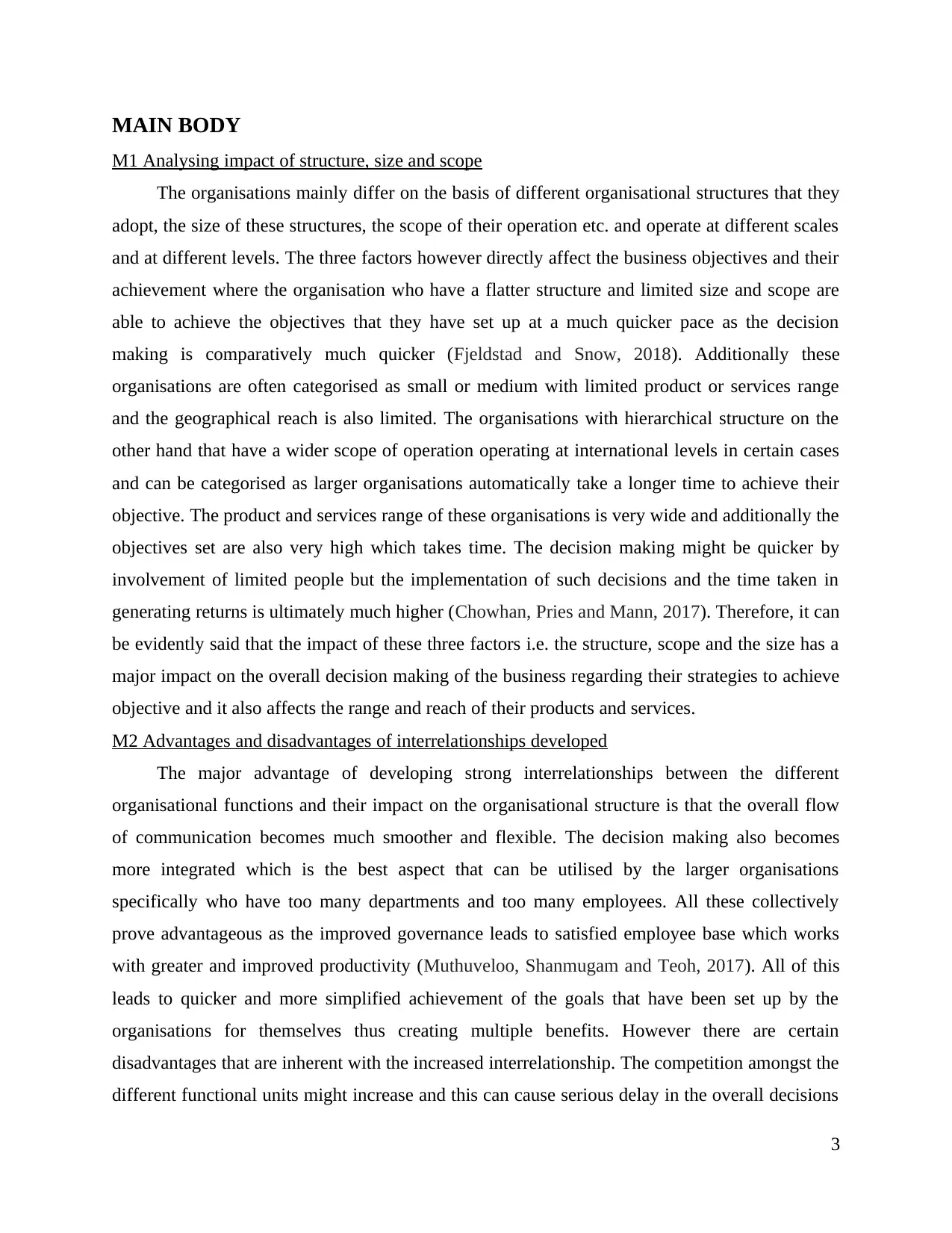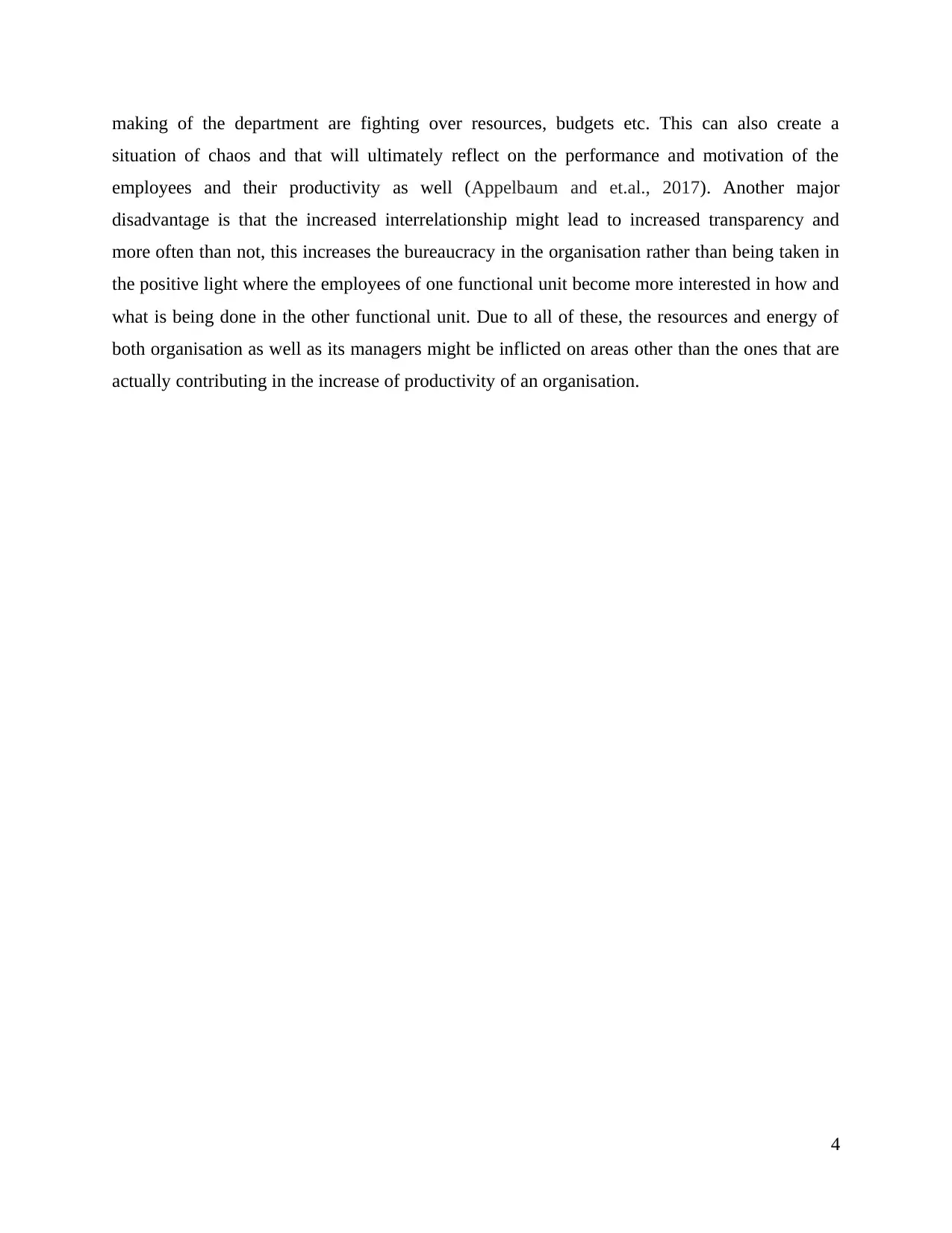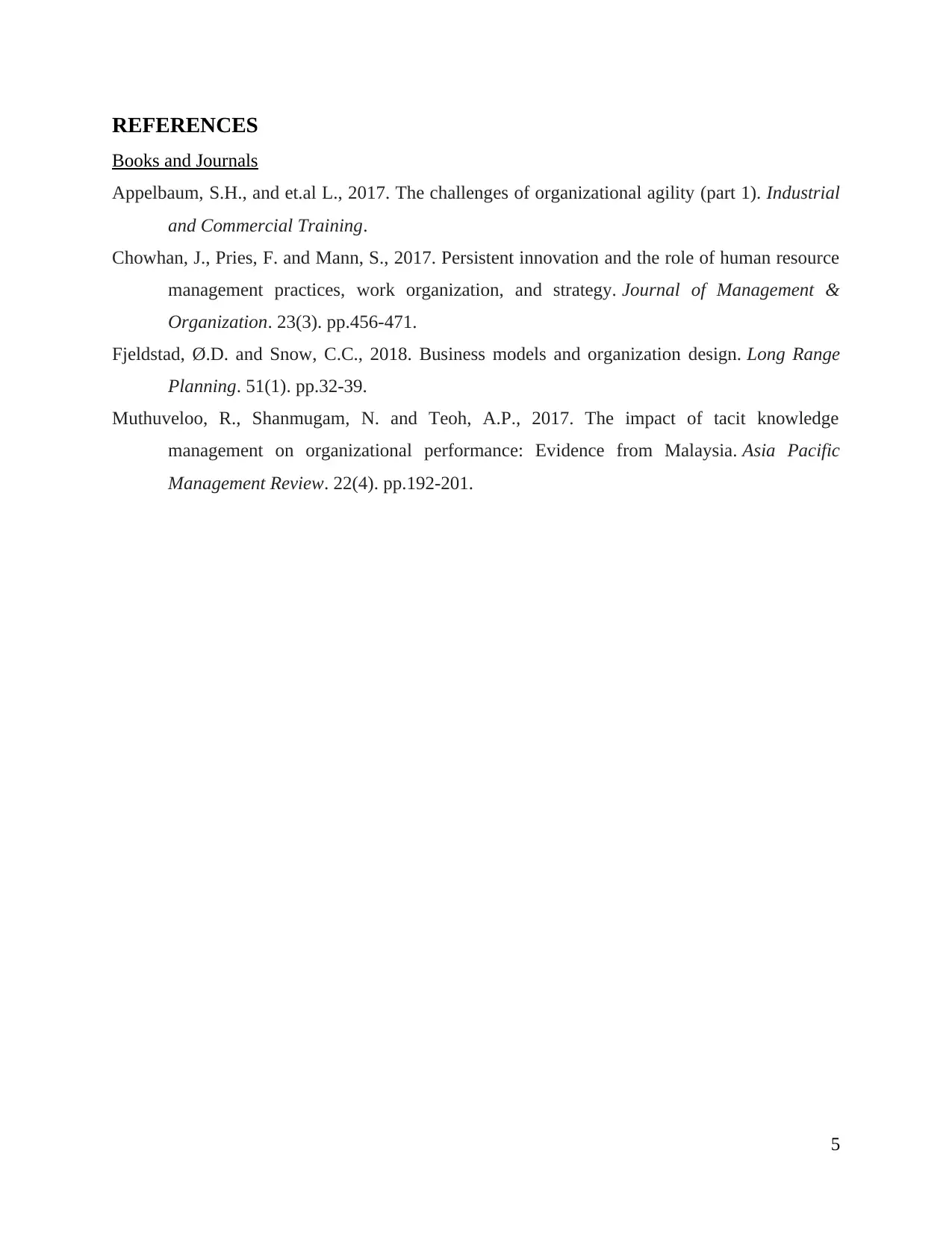Business Environment Analysis: Interrelationships Impact
VerifiedAdded on 2023/01/09
|6
|767
|63
Report
AI Summary
This report delves into the analysis of the business environment, focusing on the impact of organizational structure, size, and scope on achieving business objectives. It explores how different organizational structures, ranging from flatter structures with limited size and scope to hierarchical structure...

BUSINESS ENVIRONMENT
Paraphrase This Document
Need a fresh take? Get an instant paraphrase of this document with our AI Paraphraser

TABLE OF CONTENTS
MAIN BODY..................................................................................................................................3
M1 Analysing impact of structure, size and scope......................................................................3
M2 Advantages and disadvantages of interrelationships developed...........................................3
REFERENCES................................................................................................................................5
MAIN BODY..................................................................................................................................3
M1 Analysing impact of structure, size and scope......................................................................3
M2 Advantages and disadvantages of interrelationships developed...........................................3
REFERENCES................................................................................................................................5

MAIN BODY
M1 Analysing impact of structure, size and scope
The organisations mainly differ on the basis of different organisational structures that they
adopt, the size of these structures, the scope of their operation etc. and operate at different scales
and at different levels. The three factors however directly affect the business objectives and their
achievement where the organisation who have a flatter structure and limited size and scope are
able to achieve the objectives that they have set up at a much quicker pace as the decision
making is comparatively much quicker (Fjeldstad and Snow, 2018). Additionally these
organisations are often categorised as small or medium with limited product or services range
and the geographical reach is also limited. The organisations with hierarchical structure on the
other hand that have a wider scope of operation operating at international levels in certain cases
and can be categorised as larger organisations automatically take a longer time to achieve their
objective. The product and services range of these organisations is very wide and additionally the
objectives set are also very high which takes time. The decision making might be quicker by
involvement of limited people but the implementation of such decisions and the time taken in
generating returns is ultimately much higher (Chowhan, Pries and Mann, 2017). Therefore, it can
be evidently said that the impact of these three factors i.e. the structure, scope and the size has a
major impact on the overall decision making of the business regarding their strategies to achieve
objective and it also affects the range and reach of their products and services.
M2 Advantages and disadvantages of interrelationships developed
The major advantage of developing strong interrelationships between the different
organisational functions and their impact on the organisational structure is that the overall flow
of communication becomes much smoother and flexible. The decision making also becomes
more integrated which is the best aspect that can be utilised by the larger organisations
specifically who have too many departments and too many employees. All these collectively
prove advantageous as the improved governance leads to satisfied employee base which works
with greater and improved productivity (Muthuveloo, Shanmugam and Teoh, 2017). All of this
leads to quicker and more simplified achievement of the goals that have been set up by the
organisations for themselves thus creating multiple benefits. However there are certain
disadvantages that are inherent with the increased interrelationship. The competition amongst the
different functional units might increase and this can cause serious delay in the overall decisions
3
M1 Analysing impact of structure, size and scope
The organisations mainly differ on the basis of different organisational structures that they
adopt, the size of these structures, the scope of their operation etc. and operate at different scales
and at different levels. The three factors however directly affect the business objectives and their
achievement where the organisation who have a flatter structure and limited size and scope are
able to achieve the objectives that they have set up at a much quicker pace as the decision
making is comparatively much quicker (Fjeldstad and Snow, 2018). Additionally these
organisations are often categorised as small or medium with limited product or services range
and the geographical reach is also limited. The organisations with hierarchical structure on the
other hand that have a wider scope of operation operating at international levels in certain cases
and can be categorised as larger organisations automatically take a longer time to achieve their
objective. The product and services range of these organisations is very wide and additionally the
objectives set are also very high which takes time. The decision making might be quicker by
involvement of limited people but the implementation of such decisions and the time taken in
generating returns is ultimately much higher (Chowhan, Pries and Mann, 2017). Therefore, it can
be evidently said that the impact of these three factors i.e. the structure, scope and the size has a
major impact on the overall decision making of the business regarding their strategies to achieve
objective and it also affects the range and reach of their products and services.
M2 Advantages and disadvantages of interrelationships developed
The major advantage of developing strong interrelationships between the different
organisational functions and their impact on the organisational structure is that the overall flow
of communication becomes much smoother and flexible. The decision making also becomes
more integrated which is the best aspect that can be utilised by the larger organisations
specifically who have too many departments and too many employees. All these collectively
prove advantageous as the improved governance leads to satisfied employee base which works
with greater and improved productivity (Muthuveloo, Shanmugam and Teoh, 2017). All of this
leads to quicker and more simplified achievement of the goals that have been set up by the
organisations for themselves thus creating multiple benefits. However there are certain
disadvantages that are inherent with the increased interrelationship. The competition amongst the
different functional units might increase and this can cause serious delay in the overall decisions
3
⊘ This is a preview!⊘
Do you want full access?
Subscribe today to unlock all pages.

Trusted by 1+ million students worldwide

making of the department are fighting over resources, budgets etc. This can also create a
situation of chaos and that will ultimately reflect on the performance and motivation of the
employees and their productivity as well (Appelbaum and et.al., 2017). Another major
disadvantage is that the increased interrelationship might lead to increased transparency and
more often than not, this increases the bureaucracy in the organisation rather than being taken in
the positive light where the employees of one functional unit become more interested in how and
what is being done in the other functional unit. Due to all of these, the resources and energy of
both organisation as well as its managers might be inflicted on areas other than the ones that are
actually contributing in the increase of productivity of an organisation.
4
situation of chaos and that will ultimately reflect on the performance and motivation of the
employees and their productivity as well (Appelbaum and et.al., 2017). Another major
disadvantage is that the increased interrelationship might lead to increased transparency and
more often than not, this increases the bureaucracy in the organisation rather than being taken in
the positive light where the employees of one functional unit become more interested in how and
what is being done in the other functional unit. Due to all of these, the resources and energy of
both organisation as well as its managers might be inflicted on areas other than the ones that are
actually contributing in the increase of productivity of an organisation.
4
Paraphrase This Document
Need a fresh take? Get an instant paraphrase of this document with our AI Paraphraser

REFERENCES
Books and Journals
Appelbaum, S.H., and et.al L., 2017. The challenges of organizational agility (part 1). Industrial
and Commercial Training.
Chowhan, J., Pries, F. and Mann, S., 2017. Persistent innovation and the role of human resource
management practices, work organization, and strategy. Journal of Management &
Organization. 23(3). pp.456-471.
Fjeldstad, Ø.D. and Snow, C.C., 2018. Business models and organization design. Long Range
Planning. 51(1). pp.32-39.
Muthuveloo, R., Shanmugam, N. and Teoh, A.P., 2017. The impact of tacit knowledge
management on organizational performance: Evidence from Malaysia. Asia Pacific
Management Review. 22(4). pp.192-201.
5
Books and Journals
Appelbaum, S.H., and et.al L., 2017. The challenges of organizational agility (part 1). Industrial
and Commercial Training.
Chowhan, J., Pries, F. and Mann, S., 2017. Persistent innovation and the role of human resource
management practices, work organization, and strategy. Journal of Management &
Organization. 23(3). pp.456-471.
Fjeldstad, Ø.D. and Snow, C.C., 2018. Business models and organization design. Long Range
Planning. 51(1). pp.32-39.
Muthuveloo, R., Shanmugam, N. and Teoh, A.P., 2017. The impact of tacit knowledge
management on organizational performance: Evidence from Malaysia. Asia Pacific
Management Review. 22(4). pp.192-201.
5

6
⊘ This is a preview!⊘
Do you want full access?
Subscribe today to unlock all pages.

Trusted by 1+ million students worldwide
1 out of 6
Related Documents
Your All-in-One AI-Powered Toolkit for Academic Success.
+13062052269
info@desklib.com
Available 24*7 on WhatsApp / Email
![[object Object]](/_next/static/media/star-bottom.7253800d.svg)
Unlock your academic potential
© 2024 | Zucol Services PVT LTD | All rights reserved.





